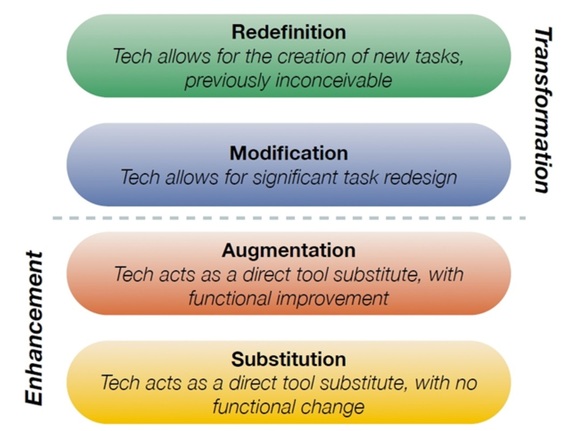This view was until I considered the technological changes that had occurred within the working environment:
- Communication was done by mail, not email;
- Reports were typed with typewriters, not computers and
- Calculations were computed manually, not with software programs.
The technology in the working environment has changed exponentially, which is why it is important that schools incorporate digital technologies in both teaching and learning to ensure they develop skills that will empower them in society. This is referred to as e-learning. The Australian Curriculum, (2014) supports this statement with the inclusion of ICT's as a General capability. "The capability involves students in learning to make the most of digital technologies available to them, adapting to new ways of doing things as technologies evolve and limiting the risks to themselves and others in a digital environment."
Working safely, legally and ethically online with students should always be a concern. Teachers need to remain vigilant, as it only takes one instance to either put students at risk or their teaching profession. However, limiting the use of ICTs because of what you think they might do is not a valid reason to deny them access. After all, students have access to information online and they need to understand how their errors in judgement can impact on their lives, both now and in the future. Teachers should guide them in their development of understanding the implications of not working safely, legally and ethically online while utilising ICTs.
With access to an abundance of information, the dynamics of the learning environment has changed. Previously, teacher directed student learning - teachers spoke and students listened. Now students are able to collaborate online (social constructivist learning theory) and expand their knowledge, with self directed learning based on their own level of interest and thirst for information on a topic (connectivism learning theory). With these advancements it is important our teaching pedagogical content knowledge be changed to Technological Pedagogical Content Knowledge (TPACK).
The TPACK framework encourages the incorporation of ICT's in our pedagogical approaches. As Koehler (n.d) states TPACK "attempts to identify the nature of knowledge required by teachers for technology integration in their teaching, while addressing the complex, multifaceted and situated nature of teacher knowledge."
For a teacher, it is critical that we carefully consider the underlying pedagogy when using e-learning. If the pedagogy of an e-learning experience is not well thought out it will undermine the implementation and can result in learners becoming disengaged (Govindasamy, 2011). The learning experience when incorporating ICTs, should engage learners into high order, critical thinking. The Australian Curriculum (2014), reinforces this with their statement "the imparting of knowledge (content) and the development of thinking skills are accepted today as a primary purpose of education. The explicitly teaching and embedding of critical and creative thinking throughout the learning areas encourages students to engage in high order thinking".
Each week I reviewed and analysed a selected ICT with the SAMR Model. [Link] I found that if I put time and effort into a lesson task I could easily scaffold an accounting lesson to incorporate and ICT that created high order thinking. This also encouraged students to be creative. The De Bono six thinking hats incorporating a wiki was an example of such an activity. [Link]
When utilising ICTs in the classroom there is a complex interaction of numerous variables that need to be considered when teaching. Teaching is not a linear experience. It is essential that I make critical judgements on those variables to enhance creative ability with the curriculum content. Things to consider are:
- Required resources - are there enough iPads available for each students to participate in the activity;
- Are students going to adhere to the safe, legal and ethical policies when working online;
- Are students going to be cooperative, and
- Is the ICT new to you but outdated to the students - is it going to engage them if it's old technology?
Hope you have enjoyed my journey.
JRay.
References
Australian Curriculum. (2014). Critical and creative thinking across the curriculum. Retrieved from http://www.australiancurriculum.edu.au/generalcapabilities/critical-and-creative-thinking/introduction/critical-and-creative-thinking-across-the-curriculum
Australian Curriculum. (2014). Information Communication and Technology (ICT) Capability. Retrieved From http://www.australiancurriculum.edu.au/generalcapabilities/information-and-communication-technology-capability/introduction/introduction
Bennett, S., Maton, K & Kervin, L. (2008). The 'digital natives' debate: A critical review of the evidence. British journal of educational technology, 39(5), 775-786. Retrieved from http://onlinelibrary.wiley.com/doi/10.1111/j. 1467-8535.2007.00793.xf/full
Candice, M. (2013, April 23). TPACK in 2 Minutes. [video file]. Retrieved from https: https://www.youtube.com/watch?v=FagVSQlZELY
Gill, L., & Dalgarno, B. (2008). Influences on pre-service tachers' preparedness to use ICTs in the classroom. Proceedings Ascilite Melbourne 2008. Retrieved from http://s3.amazonaws.com/academia.edu.documents/31070682/gill.pdf??AWSAccessKeyId=AKIAJ56TQJRTWSMTNPEA&Expires=1429665019&Signature=Jx%2BC7%2Fb3qqWH4J%2FLyNBb4xxOYlw%3D&response-content-disposition=inline
Candice, M. (2013, April 23). TPACK in 2 Minutes. [video file]. Retrieved from https: https://www.youtube.com/watch?v=FagVSQlZELY
Gill, L., & Dalgarno, B. (2008). Influences on pre-service tachers' preparedness to use ICTs in the classroom. Proceedings Ascilite Melbourne 2008. Retrieved from http://s3.amazonaws.com/academia.edu.documents/31070682/gill.pdf??AWSAccessKeyId=AKIAJ56TQJRTWSMTNPEA&Expires=1429665019&Signature=Jx%2BC7%2Fb3qqWH4J%2FLyNBb4xxOYlw%3D&response-content-disposition=inline
Govindasamy, T. (2011). Successful implementation of e-learning: Pedagogical considerations. The internet and Higher Education, 4(3), 287-299. Retrieved from http://www.qou.edu/arabic/researchProgram/eLearningResearchs/successfulImplementation.pdf
Koehler, M. (n.d). TPACK explained. Retrieved from www.tpack.org











